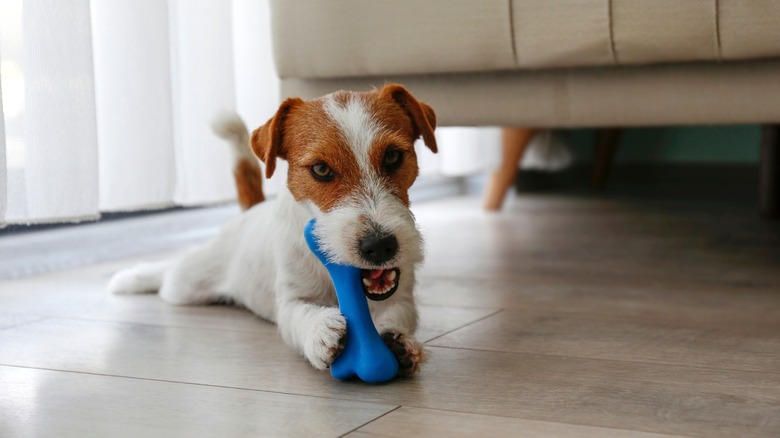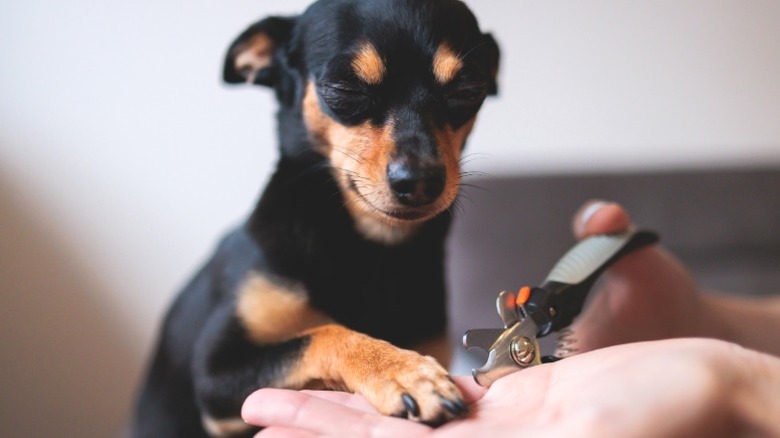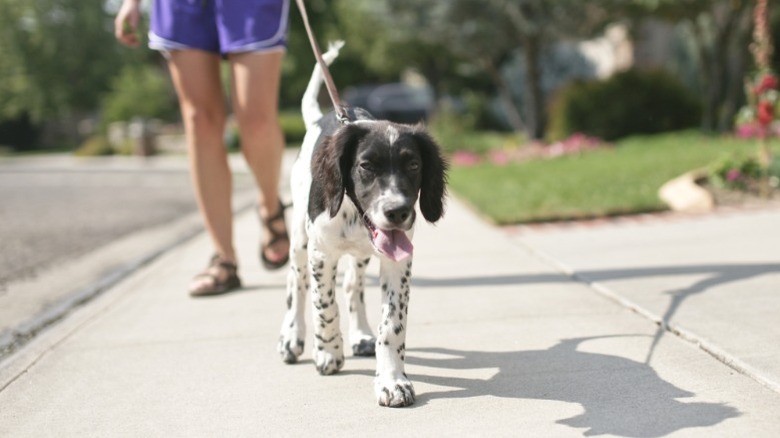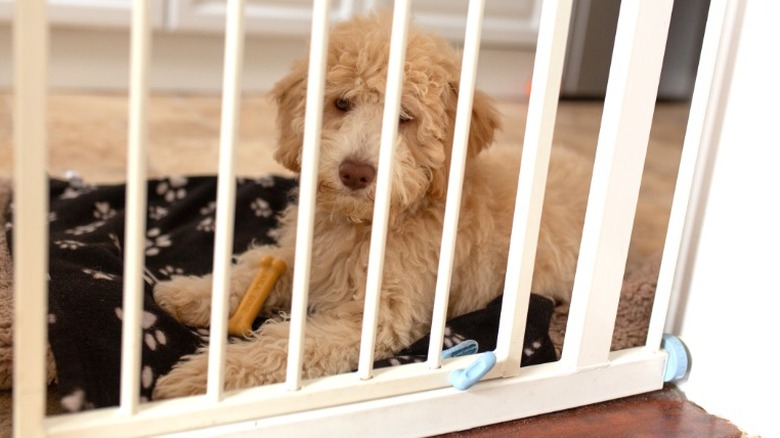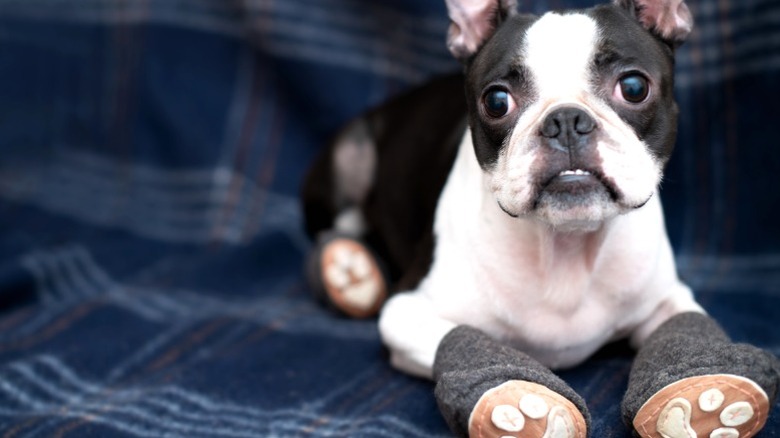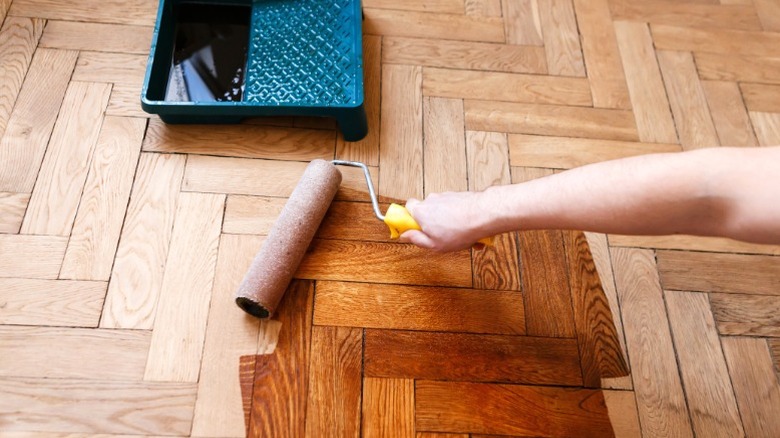Simple Tips That'll Help Prevent Your Pets From Scratching Up Your Wood Floor
We may receive a commission on purchases made from links.
Wood floors are a top choice for homeowners who take pride in their space, bringing a luxurious, natural warmth that elevates the aesthetic and can even increase your home's resale value. Of course, anything with top-end performance and looks will also cost more. At over $4,700 per installation (according to Angi), hardwood certainly doesn't come cheap. If you're willing to invest in it, it's well worth the effort to protect your flooring from unsightly and expensive dings, dents, and scratches. And that can be extra important when you have pets.
Every parent has to take the good with the bad. For those with furry, four-legged family members, sharp nails marring the floor is one of the worst issues we endure in exchange for our pets' companionship. Constant touch-ups can be irritating and full-blown flooring replacements get expensive, highlighting the need to update your floor coverings and daily routine to keep damage to a minimum. With a few minor steps, you can avoid serious headaches. Sometimes, it only takes a well-placed rug to keep your most at-risk areas scratch-free even after years of pet traffic. Put a runner in the hall, and your wood floor will stay safe as your puppy bounds toward the door when you come home from work. If you need a little extra help, you can try a few practical approaches to protect your wood floor for the long term.
Trim your pet's nails
Trimming nails should be a part of any owner's routine, regardless of their flooring. Well-groomed nails take stress off our pets, reducing the risk of pain, infections, and long-term joint issues. Protection against pet damage around the home is just an added benefit. Ideally, you'll already trim your pet's nails regularly. Introducing nail-clipping in a positive way at frequent points from a young age (i.e., as soon as you bring your puppy home) will make for a more cooperative dog and an easier, faster grooming process when they're older. Trimming the nails every week or two will keep them off the ground, making your pet comfortable and saving your floor from unnecessary scratches.
If your pet's nail growth has gotten out of hand, you can still course-correct and restore their healthy paws. It may just take a little extra time, effort, and patience. To manage overly long nails, you'll have to trim them every 3–4 days. Doing so will shorten the quick, a blood vessel in the nail that lengthens as the nail grows. You can't just lop off a huge amount of nail at one time or you'll cut the quick, causing significant pain and risking infection in the wound. Instead, you have to frequently clip or grind the nail back without nicking the vessel, letting it gradually recede. Since this can be a stressful process for the dog and their owner, you may want to partner with a groomer to safely trim the nails down.
Take your dog for walks and train calm behaviors
Although it's no replacement for regular nail-trimming, daily walks can help manage your dog's nails while keeping your pet in shape. Rough surfaces like concrete, pavement, or gravel will abrade the nail as it strikes with each step. The gentle wear won't trim the nails entirely but can let you go a little longer between nail clipping sessions. Plus, it will round the nail to make it less sharp after clipping. Freshly cut nails often have razor-like corners that can drag and snag on your floors, furniture, and more. Since hard, coarse walking surfaces act as files, they'll dull the nail so they can glance off your wood floor rather than dig into it.
The other benefit of regular walks is that they offer tiring enrichment that lends to a calmer dog. Giving your dog walks, taking them to the park, and giving them enrichment indoors will exhaust them. And a dog that can satisfy their energy levels will be happier and more docile in the house. Make the home a place for only relaxed behavior. Reward your pet when they are calm, and use the indoors as a place to take breaks from intense activity. The idea is that regular positive reinforcement will help them settle into a habit of being laid back inside. With that, they'll be less likely to tear up and scratch your wood floor or any other part of your house!
Set up barriers
While you're still struggling with your dog's rambunctious behavior indoors, you can set up an instant fix for their floor-damaging ways by physically blocking them from certain places in the house. Maybe your dog always runs to the door and scratches the floor when you walk in. In this case, you can set up a baby gate or put your dog in another room. Many baby gates have step-through doors that ease passage for people but block pets. Some options like the Womhom Extra-Wide Retractable Baby Gate can even extend across entire rooms, giving you more control over where your dog can and can't go.
Crates also bring a ton of benefits, including protecting your wood floors. Crating your dog while you're away gives them a special den space that provides a calming sense of security. At the same time, it keeps them off the floor and safe from causing damage. Dogs of any age can benefit from a crate, but they're especially helpful for young dogs as they progress through house training and learning good manners.
Use pet shoes and foot covers
Booties can be an effective solution to pet-related issues in several places, whether you want to protect their feet on hot pavement outside or prevent damage to your indoor hardwood floors. Pet shoes come in numerous sizes to match your fur baby's foot width for optimal comfort. With features like breathable designs and grippy rubber soles, your dog or cat can enjoy a stress-free fit and better traction for less slipping. They might be overkill if your only concern is protecting your floors, though, and your pet would likely appreciate it if you tried other preventative measures before slipping them into shoes.
Socks and shoes can also have limited effectiveness. They often get twisted around or fall off, and pets may try to pull them off or chew them. Dogs and cats also sweat through their paws, so any coverings could limit their ability to cool down on hot days. As an alternative, you can try claw covers to keep the paw free while dulling the nail's impact on the floor. Products like Soft Claws are inexpensive and easy to use, with the primary issue being that they may fall off unexpectedly. Though not a perfect solution, paw and nail covers may be worth discussing with your vet to see if they can be a safe way to protect your hardwood floors from scratches and scuffs.
Apply a protective finish to your wood floor
Adding a clear protective finish to your hardwood floor essentially creates a wear layer to absorb some of the abuse your pet's nails dole out. Not all finishes provide the same level of durability, so you have to be picky. Options like aluminum oxide create the toughest covering, lasting for several years without scratching. But it generally takes a professional to apply it correctly. For a more DIY-friendly avenue, you can opt for polyurethane. Polyurethane is easy to put down and low-VOC, making it safer to use around your family and pets. Reapply the finish every few years, and you'll easily extend the life of the fresh hardwood underneath it.
As you consider the durability, make sure any finish you apply is relatively grippy. Dog and cat nails can do more damage if they slide around on the floor and your pet digs in to regain traction. With products like Bona Traffic Anti Slip, you can give your wood floor a durable finish that will promote fewer slips to minimize wear as much as possible. Choose a low-gloss finish, such as matte or satin, and any scratching that may occur will stay hidden to keep a cleaner outward appearance.
